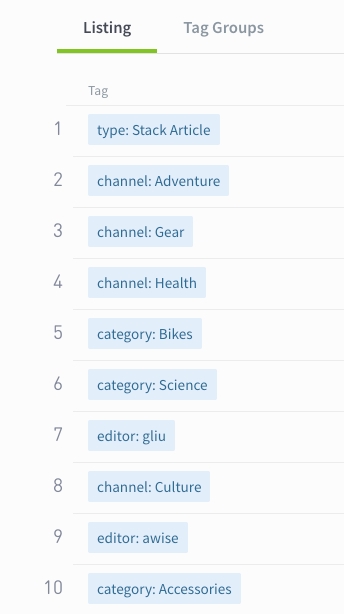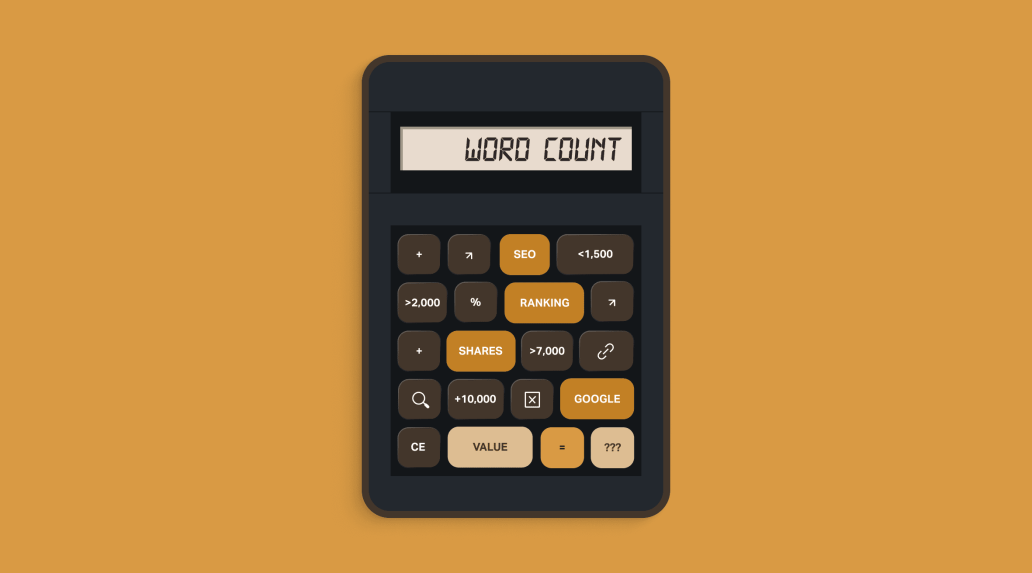Tags are some of the most useful metadata an analyst can have—and some of the most frustrating. Tags can be a wonderful way to organize content if done well, but when applied sporadically or inconsistently, they can be a headache. Without a robust process in place, tagging can be an afterthought—and a costly one, in both time and effort.
Even the best content producers with a tight tagging taxonomy feel they can do better. There’s always room for improvement. This piece will walk you through how to think about a tagging taxonomy, the questions to ask, and different strategies to use to report and track content effectively.
If you’d like to speak with one of our content analytics experts about tagging best practices, reach out to set up a session.
What’s a tag?
A tag is just a type of metadata—data about data. And if you befriend tags, your job will become easier because they help arrange, sort, and track your content.
Tags are terms (like topics, locations, page types, intended emotion, intended audience) that describe a specific piece of content, and they can be literally anything. Think hashtags on #socialmedia.
Which tags are important?
Most, if not all, content management systems (CMSes) have innate features that allow users to tag or add keywords to the content they produce. These keywords are used for both internal and external purposes, and sometimes have multiple, designated fields for specific uses. For example, tags can be used for search engine optimization, and some CMSes have a field designed solely for that purpose.
Tags can be used to evaluate performance across topics and initiatives you’ve set, and keep track of what’s been published and what’s been worked on.
When developing your tagging strategy, keep these questions in mind: What is it that I want to track? What do I want to report on? Then, think of how you want to structure your tags so you can report on this information effectively.
A lot of content professionals use subject matter tags to stamp pieces with labels describing what they’re about, but there are a host of other tagging strategies you can use to save time and create content that your audience loves. Let’s go through five that we’ve found to be most helpful.
1. Subject matter tags
Subject matter tags describe what a piece of content is about. For example, if you write an article about great places to visit in Boston in the summer, you might attach tags like “Boston,” “summer,” “summer vacation” and the names of events, landmarks and venues in the city. Depending on the scope of coverage and tagging strategy, you can add tags like “New England,” “cities,” and “Massachusetts” to that list.
With a solid subject-matter tagging structure, you can slice and dice your content data by tags to see how different topics are resonating with your audience and inform your content strategy.
These tags should reflect what the content is about in a concise manner. You don’t need to tag every detail. The key to a good subject matter tag is that it’s general enough to apply to multiple pieces of content but specific enough that it doesn’t get applied to half of your posts.
There are lots of ways to say the same thing (for example: coronavirus / Covid-19 / coronavirus pandemic; 2020 U.S. presidential election, 2020 US election, 2020 presidential election, etc.) so be conscious of that when you’re ramping up your tagging taxonomy. You don’t want to have multiple tags that mean the same thing, since that will confuse your colleagues and make it difficult to report accurately on a topic.
Some other things to keep in mind when creating subject matter tags: keep them short, avoid duplication, and watch your spelling. Also, remember that all tags are case-sensitive.
2. Editor tags
Some of our customers keep track of the stories editors work on. A tag to track editors can look like this: editor: sschwartz, with editor spelled out, and the editor’s name written with their first initial and last name.
By separating editor and the name of the person with a colon, we’re creating what’s called a parent/child category—editor being the parent, and the name of the editor the child. In this way, we can group all editors together, but also separate out stories that a specific editor works on.

3. Author tags
While Parse.ly tracks the writers of particular content, sometimes customers want to track what category of writer they are; that is, if they’re a staffer or a freelancer. In this case, we can apply a freelancer tag, or use the parent/child category naming convention, much like we do with editors, to track what type of writers are creating content.
Should you hire more writers? Are freelancers punching above their weight class? Are there types of stories that freelancers tend to cover more?
You can do the same thing with other types of author conventions. If you’re a science or health publication, you can track if writers are “experts” (doctors), vs those without formal credentials. If you cross-post content from outside contributors, they can be labeled as outside contributors, including the publication.
More recently, we’ve been using tags to track the performance of AI-assisted content.
4. Structural tags
Tags can also be used to describe the format of the content, referred to as structural tags.
For example, a feature story, explainer, investigative piece, listicle, photo gallery, or reader submission. For marketers, tags like e-book, whitepaper, resource, and case study all describe formats that your audience might want to reference. These tags will be missed by natural language processing services, like Parse.ly’s Smart Tags feature, which take tags from computers scanning the story and pulling out keywords, since they can only observe the subjects discussed, and not necessarily apply a tag that describes the format of the content the way a human would. Keep in mind that both human-applied and machine-learning-applied tags have their place.
Structural tags are used to analyze the type of content produced. How do feature stories stack up against explainers? Are new visitors to your site more likely to read a case study or a whitepaper? If you have similar content in different formats, you can compare those and see how they do among different audiences.
5. Tags for content type (sponsored content)
Use tags to differentiate between sponsored content and the rest of your content library. This is a common way for teams to compare the engagement with sponsored posts versus non-sponsored posts. This way, you can monitor the ROI of your investments and adjust accordingly. You can apply the parent/child category to sponsored content, too, especially if you are tracking clients. For example, a tag can look like this: sponsored: verizon.

Tagging in Parse.ly vs. Google Analytics and Adobe
In Parse.ly’s platform, content metadata is treated as a priority because we understand the important role tags play in executing a successful and efficient content strategy. It’s totally possible to capture all of the same metadata in Google Analytics or Adobe Analytics, but it will likely come through in a format that is only ideal for data experts (or robots) and less useful for creatives working in the content space.
How many tags are recommended?
Well, that depends on how many things you’re tracking.
A good tagging strategy incorporates a mix of subject and structural tags. A good rule of thumb: every post should have at least five subject or content tags, depending on the length and type of piece. Three or fewer tags generally doesn’t capture the extent of the story and makes tracking information difficult because it’s easy for stories to slip through. One or two structural tags is fine, especially if they’re meant to label the type of content. If you add on additional types of tags like editors or sponsored content, you’ll have at least several more.
In general, if there’s anything you want to track, make sure there’s a clearly defined label for it and that it’s applied as a tag. Stories in Parse.ly accept up to 100 tags, but almost no one goes anywhere close to that limit, so don’t worry about having too many. The danger with having too many tags is that tags are duplicative, not that they are overly descriptive; in fact, most customers don’t have enough tags to accurately describe and track their content efficiently.
Comparing tags
With a robust tagging system, you can use various metrics and features to compare the strength of particular tags. If you do have similarly-named tags, see if there’s one that overperforms and use that naming convention in place of others. Parse.ly’s Benchmarks feature allows you to compare the performance of tags over time and against other tags across a slew of metrics and see individual post performance within them.
How do tags in my CMS map to Parse.ly?
That depends on the content management system you’re using, how your site is structured, what tags are used in your CMS, the different fields in the CMS, and a bunch of other factors. Some organizations have tags for internal purposes in addition to customer-facing tags; others have separate fields for SEO keywords. In general, anything that’s a “keyword” in your CMS will flow through as a tag in Parse.ly.
Tags work best when they’re thought about before an event or a series begins, so when editorial or content teams are brainstorming, make sure that one of the last pieces of the process is identifying how that content will be labeled. It’s more difficult to change or edit tags after pieces are published than it is before, so a robust tagging taxonomy includes the process by which tags are identified and applied.
These five strategies, applied consistently and thoughtfully, will ensure that your content is labeled appropriately and effectively, and those reporting on your content will be able to do easily and efficiently.
Reach out to value@parsely.com if you’re a customer or chat with one of Parse.ly’s product specialists today about how we can help you get started using a smarter tagging strategy.
Author

Andrew Butler
Content Strategist, WordPress VIP





